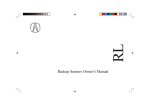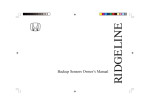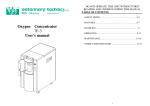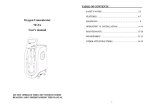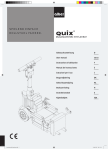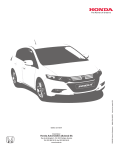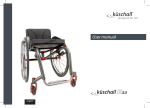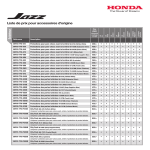Download Honda AAM 39651 User's Manual
Transcript
PILOT Backup Sensors User’s Information Manual A Few Words About Safety Your safety, and the safety of others, is very important. Operating the BACKUP SENSORS safely is an important responsibility. You will find this important safety information in a variety of forms, including: • • To help you make informed decisions about safety, we have provided operating procedures and other information on labels in the vehicle owner’s manual, and in this manual. This information alerts you to potential hazards that could hurt you or others. Of course, it is not practical or possible to warn you about all the hazards associated with operating or maintaining your vehicle. You must use your own good judgement. Safety Labels - on the vehicle. Safety Messages - preceded by safety alert symbol and one of three signal words: DANGER, WARNING, or CAUTION. These singal words mean: You WILL be KILLED or SERIOUSLY HURT if you don’t follow instructions. You CAN be KILLED or SERIOUSLY HURT if you don’t follow instructions. You CAN be HURT if you don’t follow instructions. As you read this manual, you will find information that is preceded by a symbol. This information is intended to help you avoid damage to your vehicle, other property, or the environment. • Instructions - how to use this vehicle correctly and safely. This book contains important safety information - please read it carefully. 2 Contents A Few Words About Safety .................................................................................. 2 Introduction .......................................................................................................... 4 Important Information .......................................................................................... 5 How the Backup Sensors Work ........................................................................... 6 Limitations ............................................................................................................ 9 Care of the Backup Sensors ............................................................................. 11 Operation ........................................................................................................... 12 Troubleshooting.................................................................................................. 14 3 Introduction Thank you for purchasing this Honda accessory. Please read this User’s Information Manual carefully before using the backup sensors. Keep this manual in the glove box for future reference. This User’s Information Manual should be considered a permanent part of the vehicle. It should remain with the vehicle at all times and stay with the vehicle when sold. This User’s Information Manual contains important information about the safe operation of the backup sensors. We urge you to read this manual carefully, become familiar with the controls it describes, and follow its recommendations to help make your driving trouble-free and enjoyable. 4 Important Information Before using the backup sensors, make sure you read and understand the operation and limitations of the system as discussed throughout this manual. • The backup sensors are designed to provide an audible sound when they detect large stationary objects while the vehicle is moving in reverse at low speed. However, all obstacles may not always be sensed. • Even with backup sensors, the driver should always look for obstacles near the vehicle to make sure the path is clear when driving in reverse and it is safe to park. WARNING Severe injury or death can occur to persons or objects not detected by the sensors. Never rely solely on the backup sensors and always look behind you before backing up. 5 How the Backup Sensors Work Backup Sensors The sensors are ready for operation when the backup sensor switch is ON, and the shift lever is moved into the reverse position. The sensors operate by emitting ultrasonic waves. The sensors calculate the distance to an obstacle by measuring the time that ultrasonic waves take to reflect back from an obstacle. The backup sensor switch is located on the left rear lining next to the tailgate. ON CORNER SENSOR BACKUP SENSOR SWITCH 6 CENTER SENSORS BACKUP SENSOR SWITCH LEFT REAR LINING CORNER SENSOR 8109011B How the Backup Sensors Work The sensor system is designed to alert you with a buzzer beep when the rear bumper is nearing an obstacle. Corner Sensors: The buzzer beep has three sounds: Buzzer Slow intermittent beeps Quick intermittent beeps Continuous beep Corner Sensor Distance Within 2.0 ft (60 cm) Within 1.5 ft (45 cm) Within 1.0 ft (30 cm) Center Sensor Distance Within 4.9 ft (150 cm) Within 3.3 ft (100 cm) Within 1.6 ft (50 cm) Fill Pattern 1234567890 1234567890 1234567890 Center Sensors: 4709010Y 7 How the Backup Sensors Work The sensors detect the nearest rear obstacle. The corner sensor detects the side wall. The sensors may not detect the bumpers of a tall vehicle. 8 When towing a trailer, the audible signal may keep sounding if the shift lever is moved to the reverse position. When this occurs, turn the backup sensor switch OFF. Limitations The system may not sense thin or low objects or sonic-absorptive materials such as snow, cotton, or sponge. Examples: • The sensors may not work near a garage door with electrical sensor. • The system cannot sense objects directly under the bumper. RECTANGULAR LUMBER POLE The system may not function properly under these conditions: CARDBOARD CARTON BICYCLE TIRE • After the vehicle has been sitting out in hot or cold weather. SMALL TREE SOFT SNOW CURBSTONE 4202020Y WIRE, ROPE, OR CHAIN LINK FENCE 4202030Y 9 Limitations • The sensors are covered with snow, ice, mud, etc. 4202050Y • 10 • When the system is affected by electrical equipment or devices generating an ultrasonic wave. 4202040Y When the vehicle is on a rough road, on grass, or climbing a hill. 4202060Y • When operating the vehicle in bad weather. Care of the Backup Sensors Wipe the sensors clean with a clean cloth. Flush with low-pressure water if the sensors are clogged with mud or dirt. Do not spray high-pressure water against the sensors. LOW-PRESSURE WATER 4202090Y HIGHPRESSURE WATER (Do not use.) 6D13020H 11 Operation Before using the backup sensors, become familiar with the types of sounds in relation to the distances between the sensors and the obstacle by parking your vehicle in a garage or parking space. Also confirm the obstacle detecting range of each backup sensor. 1. Apply the parking brake. 2. Turn the ignition switch to ON (II), but do not start the engine yet. ON 3. Turn the backup sensor switch ON. The switch is located on the left rear pillar next to the tailgate. 4. Move the shift lever to reverse. Confirm that the buzzer beeps for about one second when moving the shift lever to reverse. This initial beep indicates the system is working properly. ON BACKUP SENSOR SWITCH 12 BACKUP SENSOR SWITCH LEFT REAR LINING 8109011B Operation 5. With one of the doors open, check that the buzzer beeps by slowly moving a board close to each sensor as described: 6. Check that the intermittent warning beeps become quicker as you move the board closer to the sensor. Corner sensors: From 2.0 feet (60 cm) Corner sensors: About 1.5 feet (45 cm) Center sensors: From 4.9 feet (150 cm) Center sensors: About 1.0 feet (30 cm) 7. Check that the intermittent warning beeps change to a continuous beep as you move the board closer to the sensor. It may stop beeping if you move the board close too quickly. Corner sensors: About 1.0 feet (30 cm) Confirm the obstacle detecting range of each sensor. 2.0 ft (60 cm) Center sensors: About 1.6 feet (50 cm) 8. BOARD Turn the ignition switch to OFF (0). 2.0 ft (60 cm) 7611020X 13 Troubleshooting Troubleshooting With Beeps When you turn the ignition switch to ON (II), and the backup sensor buzzer beep more than once, there may be a problem with one of the sensors. Corner Sensors Two fast beeps: right sensor is faulty. Three fast beeps: left sensor is faulty. Four fast beeps: right and left sensors are faulty. Center Sensors Two slow beeps: right sensor is faulty. Three slow beeps: left sensor is faulty. Four slow beeps: right and left sensor is faulty. 14 Troubleshooting Perform the following checks if the buzzer does not beep when the vehicle is nearing an obstacle. Symptom Remedy • Clogged sensor with snow or mud • Wipe with a clean cloth or flush with low-pressure water. • Frozen sensor • Melt with lukewarm water. • Extended parking in cold weather or under blazing sun • The backup sensors may not work if the outside air temperature is below -4°F (-20°C) or above 122°F (50°C). If either of the following problems persist, have the system checked by your Honda dealer. • The buzzer beeps continuously when the shift lever is in the reverse position, and the sensors are not frozen or clogged with snow or mud. • The buzzer does not beep when the shift lever is intially shifted into reverse (R) and the backup sensor switch is turned ON. 15 © 2008 American Honda Motor Co., Inc. - All Rights AAM 39651 (0805) 08V67-SZA-1000-81EN00


















